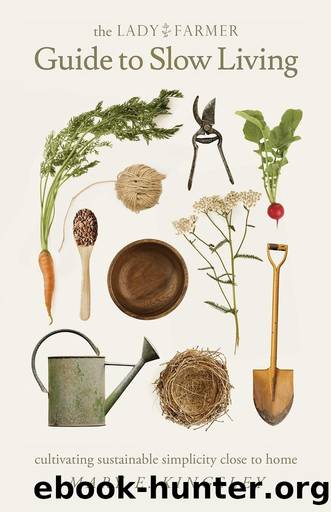The Lady Farmer Guide to Slow Living: Cultivating Sustainable Simplicity Close to Home by Mary E. Kingsley

Author:Mary E. Kingsley
Language: eng
Format: epub
Publisher: Lady Farmer
Published: 2020-01-15T00:00:00+00:00
SEED: FARM TO CLOSET
Shortly after embarking on this adventure into slow fashion, we recognized the parallels between our messaging and what weâve seen happening in the food consumer world over the last decade or so. At some point people began to wake up to how our food production and distribution systems have been hijacked by giant industries, policies and politics, creating a growing disconnection between humans and the source of their daily sustenance. The result has been a widespread consumer demand for quality and transparency and the now mainstream âFarm to Tableâ movement. We need to see this same discernment in the apparel industry as well. With initiatives such as Fashion Revolution (#whomademyclothes),36 The Ethical Fashion Forum,37 and The True Cost38 documentary, awareness of problems within the industry is growing.
The term âFarm to Closetâ sheds light on these parallels between food and fashion and highlights the fact that clothing, like food, is an agricultural product. Cotton, flax, hemp, bamboo, jute, sisal, eucalyptus, etc. are all plants that are cultivated for fibers to be made into textiles, the basis of our clothing. Sheep and alpaca provide wool. The more we can close the transparency gap between the seed in the ground, the animals in the pasture and the clothes in our closet, the more empowered we will be to make choices that do not compromise the well-being of industry workers, the environment or ourselves.
As a consumer culture with the power to shape the marketplace, when we ask questions and insist on standards regarding our clothing as well as our food, we will begin to see changes in the industry. When we use our dollar to say ânoâ to practices not compatible with a healthy, humane and sustainable society, those practices will eventually disappear.
So are you ready to take a look in your closet? We hate to be the bearer of bad news, but unfortunately, unless youâre already a highly conscious consumer, most of your wardrobe contains dangerous levels of toxins. It was probably manufactured using slavery and will most likely be in the landfill forever when you get rid of it, seeping those toxins back into our soil and water.
Itâs not a pleasant realization, but itâs the truth, and as they say, the truth will set you free.
Here are a few random tidbits (linked to articles) that might make you start looking at your closet differently:
1. Your brightly colored accessories might well contain dangerous amounts of lead.39
2. All of those fleece jackets we love? They actually shed up to 2 grams of microfiber plastic each time we wash them,40 sending them into our waterways and eventually into our drinking water and yes, onto our dinner plates. Got plastic?
3. Many of the chemicals used in the dying of fabrics can cause cancer and/or be disruptive to normal hormonal functioning.41
4. Most garments sold in the USA today are manufactured overseas, much of it produced with slave labor.42
5. The average American creates 82 lbs. of textile waste every year,43 creating an annual 10.5 million tons of clothing in landfills.
Download
This site does not store any files on its server. We only index and link to content provided by other sites. Please contact the content providers to delete copyright contents if any and email us, we'll remove relevant links or contents immediately.
The Lonely City by Olivia Laing(4746)
Animal Frequency by Melissa Alvarez(4394)
All Creatures Great and Small by James Herriot(4231)
Walking by Henry David Thoreau(3892)
Exit West by Mohsin Hamid(3777)
Origin Story: A Big History of Everything by David Christian(3648)
COSMOS by Carl Sagan(3553)
How to Read Water: Clues and Patterns from Puddles to the Sea (Natural Navigation) by Tristan Gooley(3406)
Hedgerow by John Wright(3274)
The Inner Life of Animals by Peter Wohlleben(3259)
How to Read Nature by Tristan Gooley(3249)
How to Do Nothing by Jenny Odell(3232)
Project Animal Farm: An Accidental Journey into the Secret World of Farming and the Truth About Our Food by Sonia Faruqi(3177)
Origin Story by David Christian(3146)
Water by Ian Miller(3126)
A Forest Journey by John Perlin(3026)
The Plant Messiah by Carlos Magdalena(2881)
A Wilder Time by William E. Glassley(2818)
Forests: A Very Short Introduction by Jaboury Ghazoul(2790)
